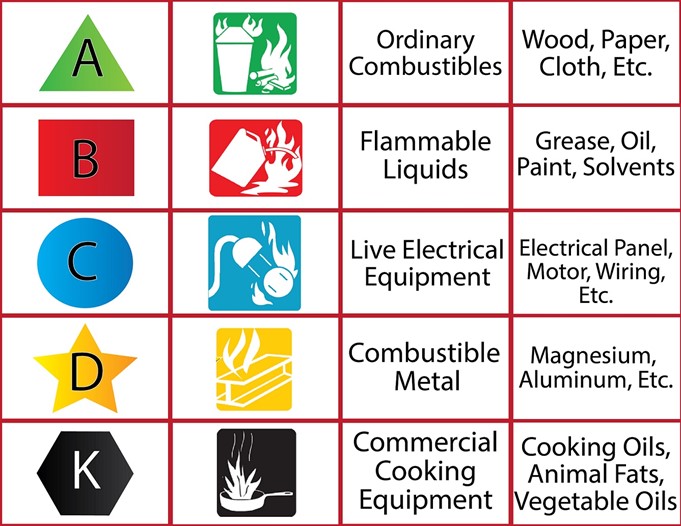Fire Extinguisher
Used properly, a portable fire extinguisher can save lives and property by extinguishing a small fire or containing it until the fire department arrives. Portable fire extinguishers, however, are not designed to fight large or spreading fires.
To choose the proper extinguisher
- For ordinary fires involving solids such as wood, paper, and cloth, choose a water, dry chemical or water mist extinguisher with a label that says Class A, AC or ABC. Do not use water on flammable liquid or electrical fires.
- For fires involving flammable liquids, choose a dry chemical or carbon dioxide extinguisher with a label that says Class BC or ABC. Never use a water extinguisher.
- For fires involving active electrical equipment, choose a dry chemical, carbon dioxide or water mist extinguisher with a label that says Class BC, C, ABC or AC.
- For fires involving metals, chose a graphite extinguisher with label that says Class D or use sand found in buckets located in laboratories. Never use an A, B, or C extinguisher on this type of fire.
- For fires involving cooking equipment such as deep fat fryer choose a wet chemical extinguisher with a label that says Class K.
To use an extinguisher
Remember the acronym PASS, keep a clear exit behind you and stand 6-8 feet away from the fire.
- Pull the pin to activate the handle.
- Aim the nozzle at the base of the fire.
- Squeeze the handle to expel the extinguishing agent at the base of the fire. (When the agent first hits the fire, the fire may briefly flare up. This should be expected.)
- Sweep the extinguishing agent from side to side pushing the fire away from you. Discharge the entire contents of the extinguisher. Do not use more than 1 fire extinguisher on a fire.
Once the fire is out, the user should carefully back away from the fire until the user is safe. Never turn your back on fire as it could flare back up.
P.A.S.S. Video - https://www.youtube.com/watch?v=PQV71INDaqY
ABCs of Fire Extinguishers
Portable fire extinguishers are classified by the type of fires they are designed to extinguish. There are five basic classifications of fuel and extinguishers, and extinguishers are labeled with either letter-shaped or pictorial symbols that indicate what types of fires they are intended for.

Classifications of Fires and Extinguishers
- Class A
- Class A fires involve ordinary combustible materials, such as cloth, wood, paper, rubber, and many plastics. Extinguishers with an A rating are designed to extinguish fires involving these ordinary combustible materials.
- Class B
- Class B fires involve flammable and combustible liquids such as gasoline, alcohol, oil-based paints, lacquers. Therefore, extinguishers with a B rating are designed to extinguish fires involving flammable and combustible liquids.
Note: Do not attempt to extinguish a fire involving flammable gas unless there is reasonable assurance the source of fuel can be promptly shut off. In fact, if the only fuel burning is the leaking gas, the best method for extinguishing the fire is to shut off the fuel supply. Extinguishing a flammable gas fire, without shutting off the fuel, will allow unburned gas to escape into the atmosphere, which may permit a dangerous accumulation of gas to develop, and an explosion may occur if the gas is exposed to an ignition source.
- Class C
- Class C fires involve energized electrical equipment. Extinguishers with a C rating are designed for use with fires involving energized electrical equipment.
- Class D
- Class D fires involve combustible metals, such as magnesium, titanium, and sodium. Extinguishers with a D rating are designed to extinguish fires involving combustible metals.
Note: Common extinguishing agents may react with a combustible metal fire causing the severity of the fire to increase. The most common method for extinguishing a combustible metal fire is to cover the burning material with a dry powder, such as sand, which will not react with the material. If you store or use combustible metals, contact the Fire Prevention Services office for a consultation regarding the proper type and amount of extinguishing agent you should have available.
- Class K
- Class K fires involve vegetable oils, animal oils, or fats in cooking appliances. Extinguishers with a K rating are designed to extinguish fires involving vegetable oils, animal oils, or fats utilized in commercial cooking appliances.
Note: Extinguishers with a K rating are normally required where deep-fryers and/or griddles are utilized to prepare large quantities of food. An example would be a commercial kitchen similar to those found in restaurants and cafeterias.
